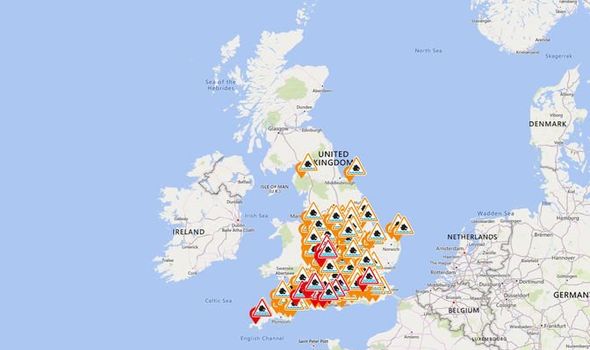Flood Alerts Explained: Understanding Flood Warnings And Taking Action

Table of Contents
Types of Flood Warnings and Alerts
Different levels of flood alerts signal varying degrees of risk. Knowing the difference between a watch, advisory, warning, and flash flood warning is vital for taking appropriate action.
Flood Watch
A flood watch means conditions are favorable for flooding. It's a precautionary measure, urging you to monitor the situation closely and prepare. Think of it as a "heads-up."
- Increased rainfall is expected in your area, potentially leading to rising water levels.
- River levels are rising, but are not yet at dangerous levels. This is a good time to check your property's flood risk.
- Prepare your emergency kit. Include essential supplies like water, non-perishable food, medications, flashlights, and a first-aid kit. Consider having important documents stored in a waterproof container.
- Monitor local news and weather reports for updates and potential changes to the situation. Stay informed about the evolving weather patterns and any updated flood risk assessments.
Flood Advisory
A flood advisory indicates that flooding is occurring or is imminent in specific areas. This is a step up from a watch; take immediate action to protect yourself and your property.
- Minor flooding is occurring or is expected to occur soon. This might involve some localized street flooding or inundation of low-lying areas.
- Be cautious while driving; avoid flooded roads. Remember, "Turn around, don't drown"—floodwaters can be deceptively deep and swift.
- Move valuables to higher ground. This includes furniture, electronics, and other important items that could be damaged by floodwater.
- Secure your home against potential flood damage. Bring outdoor furniture inside, and consider sandbagging vulnerable areas.
Flood Warning
A flood warning means that flooding is happening now and poses a significant threat to life and property. This is a serious situation requiring immediate action.
- Serious flooding is occurring. Water levels are high and rapidly rising, posing a direct threat to lives and property.
- Follow evacuation orders from authorities immediately. Do not hesitate; your safety is paramount.
- Seek higher ground immediately. If you're instructed to evacuate, leave your home promptly and head to a designated shelter or a safe location.
- Contact emergency services if needed. If you or someone you know is in immediate danger, call emergency services for assistance.
Flash Flood Warning
A flash flood warning signifies a sudden and dangerous flood, often with little to no warning. This is the most dangerous type of flood alert, demanding immediate action.
- Rapid flooding is occurring. Water levels are rising extremely quickly, often due to intense rainfall or dam failures.
- Move to higher ground quickly. Time is of the essence in a flash flood; every second counts.
- Do not attempt to drive through floodwaters. Even a few inches of water can sweep a car away.
- This is the most dangerous type of flood alert. Immediate action is essential to save lives.
Understanding Flood Risk in Your Area
Knowing your flood risk is vital in preparing for potential flood alerts.
Identifying Flood-Prone Zones
Learn if your property is located in a high-risk flood zone. Understanding your risk can help you prepare and mitigate potential damage.
- Check FEMA flood maps (or equivalent in your country). These maps identify areas with a high probability of flooding.
- Contact your local emergency management agency. They can provide specific information about your area's flood risk and preparedness resources.
- Understand your property's elevation and proximity to water sources. Higher elevation generally reduces flood risk, but proximity to rivers, streams, or other bodies of water increases it.
Developing a Flood Preparedness Plan
Create a detailed plan outlining steps to take before, during, and after a flood. This plan should be shared with your family members and updated regularly.
- Identify safe evacuation routes. Know multiple routes in case one is blocked by floodwaters.
- Assemble an emergency kit (food, water, medications, important documents). Keep this kit readily accessible and regularly check its contents.
- Establish a communication plan with family and friends. Designate a meeting point outside of the affected area and establish ways to contact each other during the event of a flood.
- Consider flood insurance. This can provide financial protection in case your property is damaged by a flood.
Actions to Take During a Flood Alert
Knowing what to do during a flood alert is key to staying safe.
Evacuation Procedures
Follow all evacuation orders promptly. Never attempt to drive through floodwaters—it's extremely dangerous and can be fatal.
- Know your designated evacuation route and shelter locations. Familiarize yourself with these routes ahead of time, so you won’t be caught off-guard.
- Bring essential supplies. This might include your emergency kit, medications, and other valuable items.
- Secure your home as much as possible before leaving. This could include turning off utilities and bringing valuable items to higher ground.
- Turn off utilities if possible. This includes electricity, gas, and water to prevent further damage.
Staying Safe During a Flood
If evacuation is not necessary, move to the highest level of your home and stay informed about the evolving situation.
- Monitor weather reports and official updates. Stay informed about the flood situation through credible sources.
- Avoid contact with floodwater. Floodwaters often contain dangerous contaminants, including bacteria, sewage, and chemicals.
- Be cautious of downed power lines and other hazards. Downed power lines pose a significant risk of electrocution.
Conclusion
Staying informed about flood alerts is paramount for protecting yourself and your community. Understanding the different types of flood warnings—from a flood watch to a flash flood warning—and knowing how to respond appropriately can significantly reduce the risk of injury and property damage. By developing a flood preparedness plan and taking decisive action when a flood alert is issued, you'll be well-equipped to face the challenges posed by flooding. Remember, preparedness is key! Take the time today to learn more about flood alerts in your area and create your personal action plan. Don't wait until it's too late; prepare for flood warnings and protect your family and property.

Featured Posts
-
 When To Fly Around Memorial Day 2025 Avoid The Crowds
May 25, 2025
When To Fly Around Memorial Day 2025 Avoid The Crowds
May 25, 2025 -
 Dc Love Story Tragedy After A Long Distance Romance
May 25, 2025
Dc Love Story Tragedy After A Long Distance Romance
May 25, 2025 -
 Euronext Amsterdam Stock Market Soars 8 Following Trump Tariff Announcement
May 25, 2025
Euronext Amsterdam Stock Market Soars 8 Following Trump Tariff Announcement
May 25, 2025 -
 Local News Triumph Myrtle Beach Newspaper Garners 59 Sc Press Association Awards
May 25, 2025
Local News Triumph Myrtle Beach Newspaper Garners 59 Sc Press Association Awards
May 25, 2025 -
 How To Interpret The Net Asset Value Nav Of Amundi Msci World Ii Ucits Etf Usd Hedged Dist
May 25, 2025
How To Interpret The Net Asset Value Nav Of Amundi Msci World Ii Ucits Etf Usd Hedged Dist
May 25, 2025
